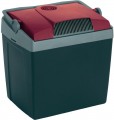Volume
The volume of the working chamber of the car refrigerator. The larger the volume, the more products can be loaded into the unit at a time. When choosing according to this parameter, it makes sense to select a model with a margin, because it is not recommended to load products too tightly — this adversely affects the quality of the device. On the other hand, note that the volumetric container and dimensions will have the appropriate ones.
Holds bottles
The total number of bottles that can fit in a cooler bag or container. Depending on the product and manufacturer, the number may vary based on the capacity of the bottles, from 0.5-liter to more spacious 1.5-liter bottles. Therefore, when comparing this feature, only models with an indicated total number of bottles at the same volume should be considered. Nevertheless, this information will help better visualize the internal dimensions of the box or bag.
Operation mode
—
Cooling. A mode of operation in which the food placed inside is cooled to a temperature just above zero (the minimum threshold is usually around 4 °C). Present in all car refrigerators by definition.
—
Freeze. An operating mode designed to cool the food placed in the cooking chamber to a temperature below zero (in some models down to -18°C). In some models, it can also be used for making ice in special compartments.
—
Heating. The mode of operation for heating products is especially useful in the cold season. Many models with this function have fairly good heating characteristics, allowing you to heat food in them to a hot state. This mode is also good for keeping food hot. However, car refrigerators with a heating function are usually quite expensive.
Min. cooling temperature
The minimum temperature to which the refrigerator is able to cool the product placed in it when operating in cooling mode. It should be taken into account that the minimum cooling temperature is not always achievable in fact: the actual cooling temperature depends on the ambient temperature and on the capacity of the refrigerator for maximum cooling (for more details on the calculation formula, see "Maximum cooling per (°C)"). However, this applies only to refrigerators that are not equipped with compressors (see Compressor);
compressor models are able to reach the minimum cooling temperature regardless of external conditions.
Сooling energy consumption
The power consumed by the refrigerator when operating in cooling mode. The greater this power, the more performant the refrigerator is, usually, and the less time it takes to cool the product. On the other hand, note that more power means more power consumption — which can be critical, for example, during long-term operation from a car battery (that is, when the car engine is turned off).
Supply voltage
The supply voltage for which the car refrigerator is designed. There are several standard options:
—
12 V Standard voltage of the on-board mains of passenger cars, as well as many minibuses and light trucks. Supported by most modern car refrigerators.
—
24 V Standard voltage of the on-board mains of buses, heavy trucks and other large equipment; also found in some SUVs. Car refrigerators "only for 24 V" are almost never produced; as a rule, this option is provided in addition to 12 V.
—
230 V Powered by a standard household outlet. Usually a backup option, in case the refrigerator needs to be turned on outside the car for a while — for example, to pre-cool before a trip. In addition, units with such power can be used as an improvised replacement for a stationary refrigerator — for example, when going to the country, where there is no permanent refrigerator.
Energy label
A parameter that characterizes the efficiency of energy consumption. In modern car refrigerators, there are classes from A + and above; the more “pluses” in the marking, the more economical the device.
Note that the energy class does not describe the actual power consumption, but the efficiency of the device compared to similar models. Therefore, for example, a large
built -in A++ class unit may consume more energy than a smaller A+ class
armrest refrigerator.

